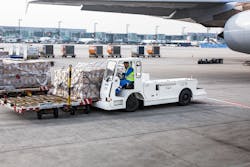MULAG’s Pulsar 7 E is a container pallet transporter with electric drive that can transport heavy cargo, standard LD and MD containers and pallets up to 196" (5640 mm) without CO2 emissions.
The cargo loader is powered by two 12 kW asynchronous motors and two 465 Ah traction batteries. The vehicle travels up to 15.5 mph (25 km/h).
“Ground service providers and airlines benefit from the quality and reliability of the Pulsar 7 E, which builds on decades of experience in the development and manufacture of container pallet transporters,” says Daniel Müller, area sales manager for GSE at MULAG. “Thanks to the innovative electric drive technology, the product requires less maintenance and can be used ecologically sustainable in airport operations.”
Following the introduction and development of the Pulsar 7E electric container transporter in 2015, officials at MULAG introduced the Pulsar 7 SL side-loader container transporter at the end of 2021. The Pulsar 7 SL offers a revised cab concept and new electronic control platform.
“The technical design of the Pulsar container pallet transporters was optimized in the course of further development by means of a modular component system, and electrification and digitalization were further advanced,” says Müller.
As part of a product family, there are also diesel-powered Pulsar container transporters with 7 tonne and 14 tonne payloads, as well as a side-loading version where container pallets can also be received and transported at 90 degrees from the side.
“The main difference besides the payload is the size of the roller bed for handling up to three pallets at a time. In recent years, there has also existed a high-loader variant as a special solution in this product range, which is mainly used in the defense sector,” Müller says.
MULAG’s product range will continue to be developed and expanded, in regard to future-oriented drive technologies, Müller adds.
Units from the Pulsar container pallet transporter range are in use at European and international airports in a variety of configurations, including some of which that are customer-specific, Müller says.
About the Author
Josh Smith
Editor
Josh Smith served as editor of Ground Support Worldwide as editor from 2016 through 2024. He oversaw production of the print magazine, created GSW's newsletters on a daily basis, and updated the latest news on AviationPros.com.

